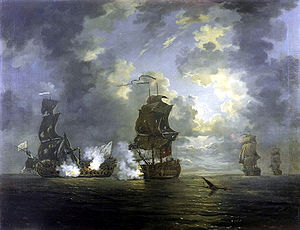HMS Monmouth (1667)
 The Capture of Foudroyant by HMS Monmouth, 28 February 1758. Painting by F. Swaine. National Maritime Museum, London. | |
| Career (Great Britain) | |
|---|---|
| Name: | HMS Monmouth |
| Builder: | Phineas Pett II, Chatham dockyard |
| Launched: | 1667 |
| Honours and awards: |
Participated in: |
| Fate: | Broken up, 1767 |
| General characteristics as built[1] | |
| Class and type: | 66-gun third rate ship of the line |
| Tons burthen: | 856 bm |
| Length: | 118 ft 9 in (36.20 m) (keel) |
| Beam: | 36 ft 10 in (11.23 m) |
| Depth of hold: | 15 ft 6 in (4.72 m) |
| Propulsion: | Sails |
| Sail plan: | Full rigged ship |
| Armament: | 66 guns of various weights of shot |
| General characteristics after 1700 rebuild[2] | |
| Class and type: | 66-gun third rate ship of the line |
| Tons burthen: | 944 tons (959.1 tonnes) |
| Length: | 147 ft 9 in (45.03 m) (gundeck) |
| Beam: | 38 ft (12 m) |
| Depth of hold: | 16 ft (4.9 m) |
| Propulsion: | Sails |
| Sail plan: | Full rigged ship |
| Armament: | 66 guns of various weights of shot |
| General characteristics after 1718 rebuild[3] | |
| Class and type: | 1706 Establishment 70-gun third rate ship of the line |
| Tons burthen: | 1174 tons (1192.8 tonnes) |
| Length: | 150 ft (46 m) (gundeck) |
| Beam: | 41 ft (12 m) |
| Depth of hold: | 17 ft 4 in (5.28 m) |
| Propulsion: | Sails |
| Sail plan: | Full rigged ship |
| Armament: |
70 guns:
|
| General characteristics after 1742 rebuild[4] | |
| Class and type: | 1733 proposals 70-gun third rate ship of the line |
| Tons burthen: | 1225 tons (1244.7 tonnes) |
| Length: | 151 ft (46 m) (gundeck) |
| Beam: | 43 ft 5 in (13.23 m) |
| Depth of hold: | 17 ft 9 in (5.41 m) |
| Propulsion: | Sails |
| Sail plan: | Full rigged ship |
| Armament: |
70 guns:
|
HMS Monmouth was a 66-gun third-rate ship of the line of the Royal Navy,[1] and was the second ship to be named for the town of Monmouth in Wales. She served from 1667 to 1767, winning ten battle honours over a century of active service. She was rebuilt a total of three times during her career—each time effectively becoming a completely new ship.
She was built at Chatham Dockyard in 1667 by Phineas Pett II—seeing action whilst still in the Thames, during the Raid on the Medway, and fought at the Battle of Solebay in 1672, shortly followed by the Battle of Texel in 1673. She fought at the Battle of Barfleur in 1692. Monmouth underwent her first rebuild at Woolwich Dockyard in 1700, remaining a 66-gun ship.[2] She fought at the Battle of Vigo Bay in 1702, and at the Siege of Gibraltar and Velez Malaga in 1704.
In 1707, she had belonged to Admiral Sir Cloudesley Shovell's fleet. She saw action during the unsuccessful Battle of Toulon and was present during the great naval disaster off the Isles of Scilly when Shovell and four of his ships (Association, Firebrand, Romney and Eagle) were lost, claiming the lives of nearly 2,000[5] sailors. Monmouth suffered little to no damage and finally managed to reach Portsmouth.
Her second rebuild was carried out at Portsmouth Dockyard, where she was increased to a 70-gun ship built according to the 1706 Establishment, and relaunched on 3 June 1718.[3] On 7 September 1739 Monmouth was ordered to be taken to pieces and rebuilt for what was to be the final time at Deptford according to the 1733 proposals of the 1719 Establishment. She was relaunched on 6 September 1742.[4]
In 1747, she fought at Finisterre and Ushant, and in 1758 she captured the larger French ship Foudroyant.[6] Monmouth was also present at Belle Île in 1761.
After a hundred years of honourable service, she was finally broken up in 1767; a newspaper of the time gave her epitaph as 'There was no ship she ever chased that she did not overtake: there was no enemy she ever fought that she did not capture.'[citation needed]
Notes
- ↑ 1.0 1.1 Lavery, Ships of the Line vol.1, p161.
- ↑ 2.0 2.1 Lavery, Ships of the Line vol.1, p167.
- ↑ 3.0 3.1 Lavery, Ships of the Line vol.1, p168.
- ↑ 4.0 4.1 Lavery, Ships of the Line vol.1, p171.
- ↑ Sobel, Dava, Longitude: The True Story of a Lone Genius Who Solved the Greatest Scientific Problem of His Time, Fourth Estate Ltd., London 1998, p. 6, ISBN 1-85702-571-7
- ↑ Capture of Foudroyant, NMM.
References
- Lavery, Brian (2003) The Ship of the Line - Volume 1: The development of the battlefleet 1650-1850. Conway Maritime Press. ISBN 0-85177-252-8.
- The capture of the Foudroyant by HMS Monmouth. National Maritime Museum. Retrieved 1 December 2007.
| ||||||||||||||||||||
